EX-99.1
Published on June 17, 2019
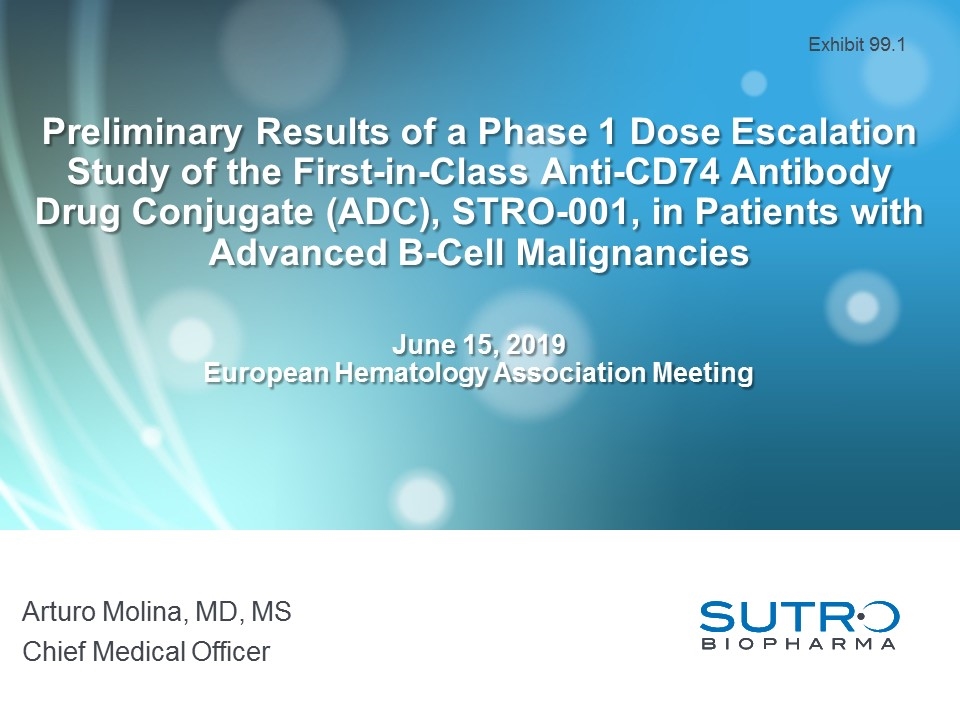
Preliminary Results of a Phase 1 Dose Escalation Study of the First-in-Class Anti-CD74 Antibody Drug Conjugate (ADC), STRO-001, in Patients with Advanced B-Cell Malignancies June 15, 2019 European Hematology Association Meeting Arturo Molina, MD, MS Chief Medical Officer Exhibit 99.1

Summary and Conclusions (1) STRO-001 is the first ADC generated with novel cell-free protein synthesis technology and site-specific conjugation to be tested in the clinic. STRO-001 has been generally well tolerated. Most AEs are grade 1 or 2. MTD has not been reached. Enrollment is ongoing at: 0.65 mg/kg in multiple myeloma (MM) cohort. 0.91 mg/kg in non-Hodgkin lymphoma (NHL) cohort. Mild infusion reactions have been observed, requiring standard of care pre-medications. Data as of May 14, 2019
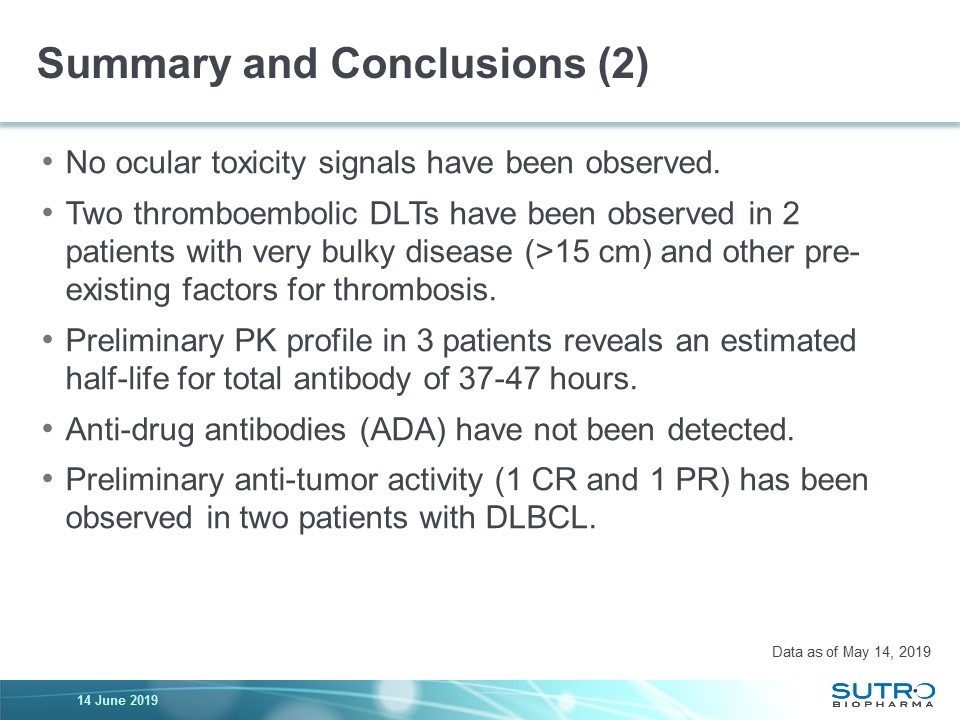
Summary and Conclusions (2) No ocular toxicity signals have been observed. Two thromboembolic DLTs have been observed in 2 patients with very bulky disease (>15 cm) and other pre-existing factors for thrombosis. Preliminary PK profile in 3 patients reveals an estimated half-life for total antibody of 37-47 hours. Anti-drug antibodies (ADA) have not been detected. Preliminary anti-tumor activity (1 CR and 1 PR) has been observed in two patients with DLBCL. Data as of May 14, 2019
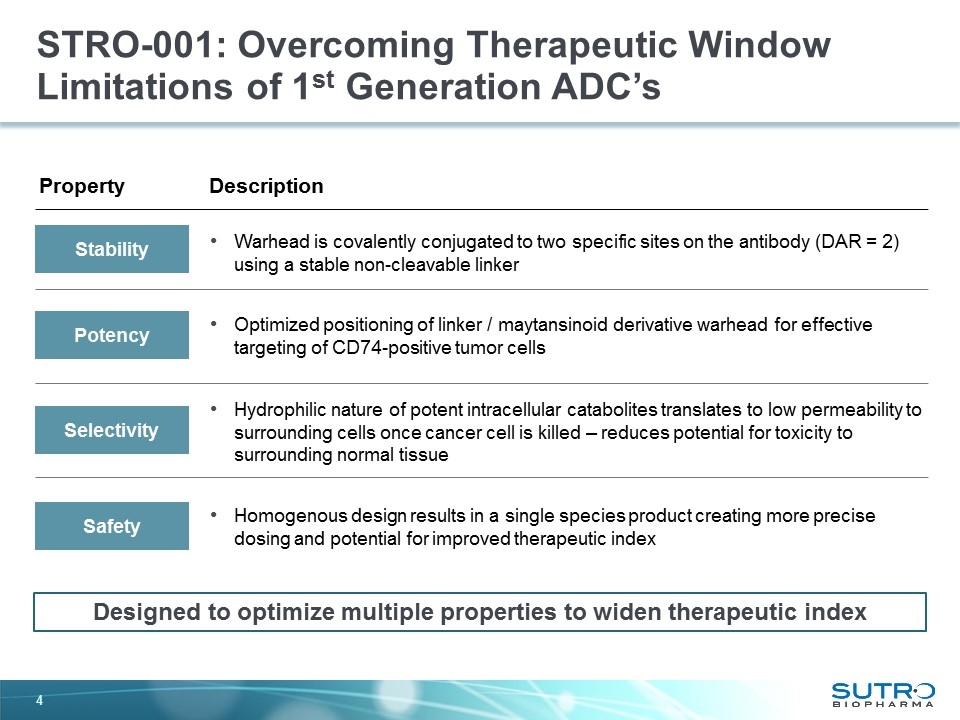
STRO-001: Overcoming Therapeutic Window Limitations of 1st Generation ADC’s Property Description Stability Safety Homogenous design results in a single species product creating more precise dosing and potential for improved therapeutic index Warhead is covalently conjugated to two specific sites on the antibody (DAR = 2) using a stable non-cleavable linker Potency Optimized positioning of linker / maytansinoid derivative warhead for effective targeting of CD74-positive tumor cells Selectivity Hydrophilic nature of potent intracellular catabolites translates to low permeability to surrounding cells once cancer cell is killed – reduces potential for toxicity to surrounding normal tissue Designed to optimize multiple properties to widen therapeutic index
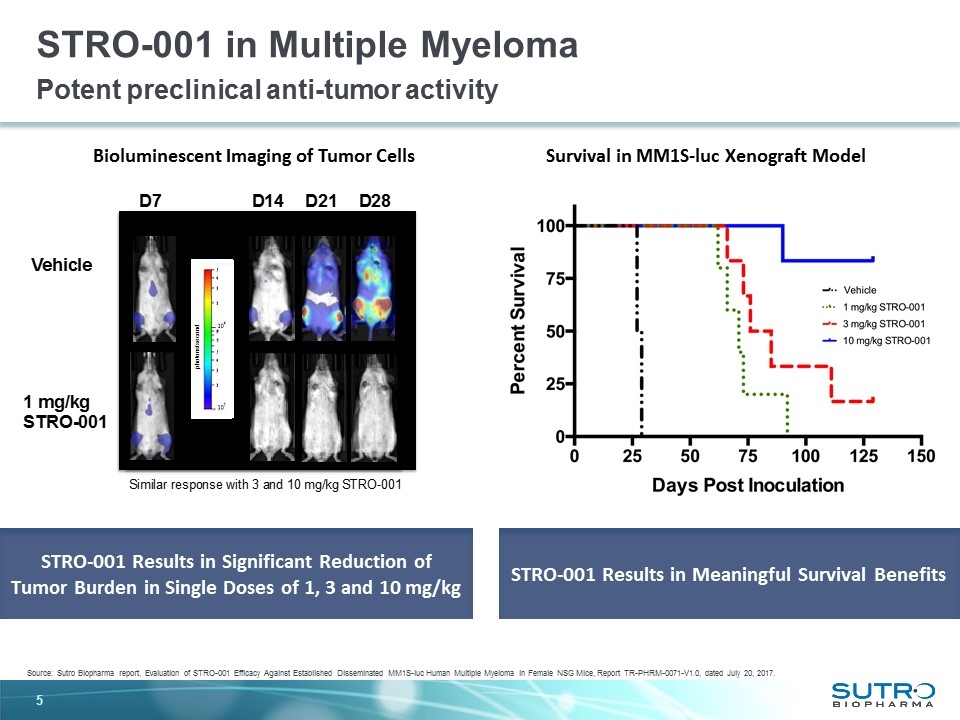
STRO-001 in Multiple Myeloma Potent preclinical anti-tumor activity Bioluminescent Imaging of Tumor Cells Survival in MM1S-luc Xenograft Model STRO-001 Results in Significant Reduction of Tumor Burden in Single Doses of 1, 3 and 10 mg/kg STRO-001 Results in Meaningful Survival Benefits Source: Sutro Biopharma report, Evaluation of STRO-001 Efficacy Against Established Disseminated MM1S-luc Human Multiple Myeloma in Female NSG Mice, Report TR-PHRM-0071-V1.0, dated July 20, 2017.
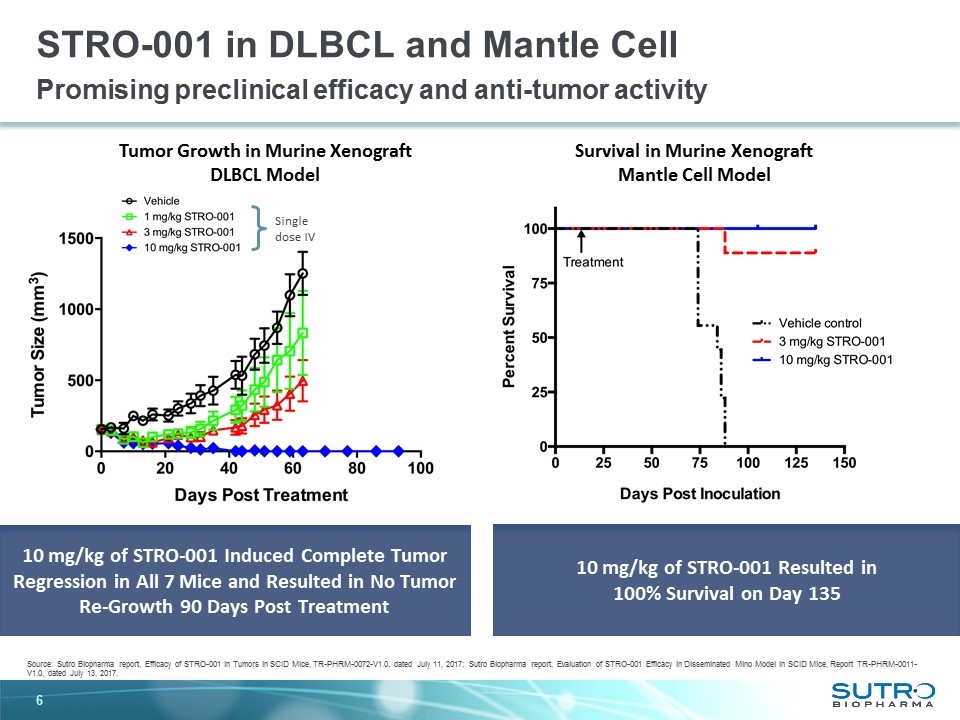
STRO-001 in DLBCL and Mantle Cell Promising preclinical efficacy and anti-tumor activity Single dose IV 10 mg/kg of STRO-001 Induced Complete Tumor Regression in All 7 Mice and Resulted in No Tumor Re-Growth 90 Days Post Treatment Tumor Growth in Murine Xenograft DLBCL Model Survival in Murine Xenograft Mantle Cell Model 10 mg/kg of STRO-001 Resulted in 100% Survival on Day 135 Source: Sutro Biopharma report, Efficacy of STRO-001 in Tumors in SCID Mice, TR-PHRM-0072-V1.0, dated July 11, 2017; Sutro Biopharma report, Evaluation of STRO-001 Efficacy in Disseminated Mino Model in SCID Mice, Report TR-PHRM-0011-V1.0, dated July 13, 2017.
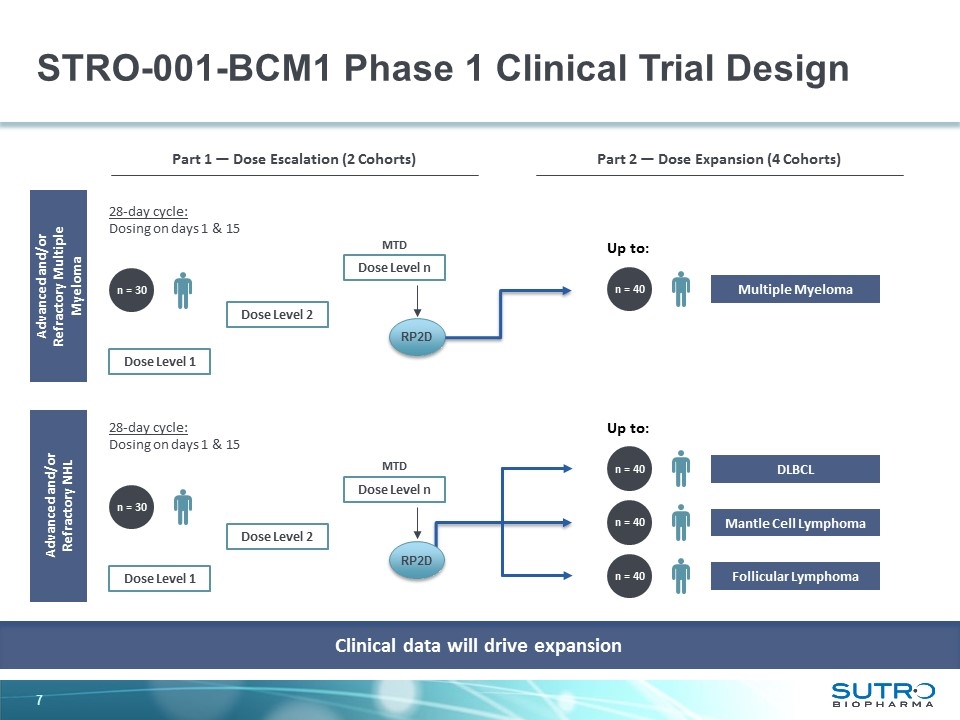
STRO-001-BCM1 Phase 1 Clinical Trial Design MTD Advanced and/or Refractory Multiple Myeloma Advanced and/or Refractory NHL Dose Level 2 Dose Level n RP2D RP2D Clinical data will drive expansion Part 1 — Dose Escalation (2 Cohorts) Part 2 — Dose Expansion (4 Cohorts) n = 40 Multiple Myeloma n = 40 DLBCL n = 40 Mantle Cell Lymphoma n = 40 Follicular Lymphoma MTD Dose Level 1 28-day cycle: Dosing on days 1 & 15 n = 30 Dose Level 1 28-day cycle: Dosing on days 1 & 15 n = 30 Dose Level 2 Dose Level n Up to: Up to:
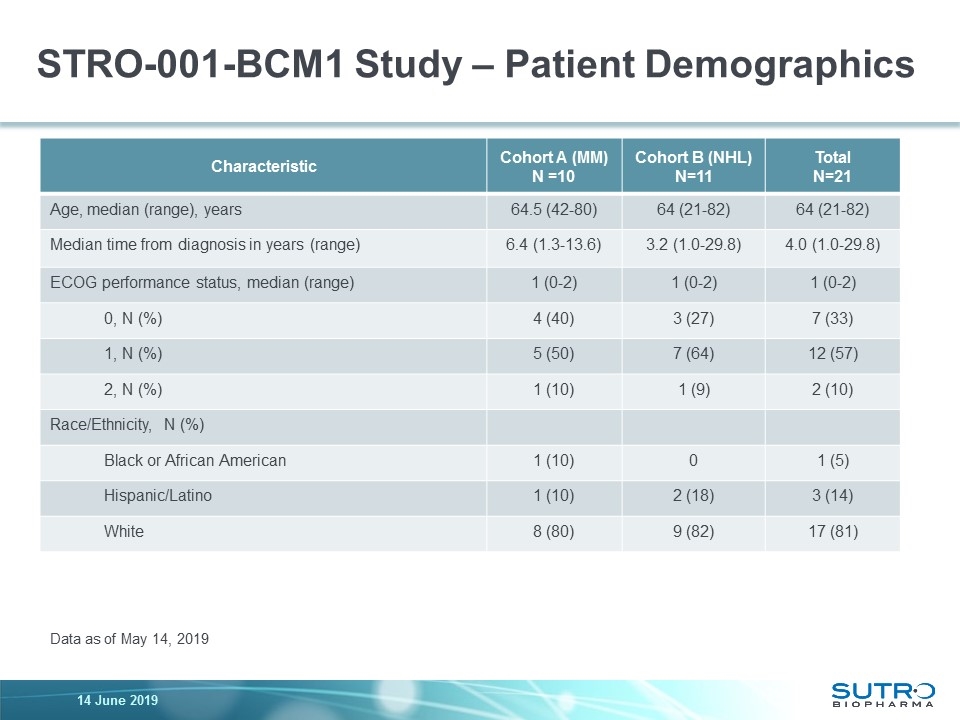
Characteristic Cohort A (MM) N =10 Cohort B (NHL) N=11 Total N=21 Age, median (range), years 64.5 (42-80) 64 (21-82) 64 (21-82) Median time from diagnosis in years (range) 6.4 (1.3-13.6) 3.2 (1.0-29.8) 4.0 (1.0-29.8) ECOG performance status, median (range) 1 (0-2) 1 (0-2) 1 (0-2) 0, N (%) 4 (40) 3 (27) 7 (33) 1, N (%) 5 (50) 7 (64) 12 (57) 2, N (%) 1 (10) 1 (9) 2 (10) Race/Ethnicity, N (%) Black or African American 1 (10) 0 1 (5) Hispanic/Latino 1 (10) 2 (18) 3 (14) White 8 (80) 9 (82) 17 (81) STRO-001-BCM1 Study – Patient Demographics Data as of May 14, 2019
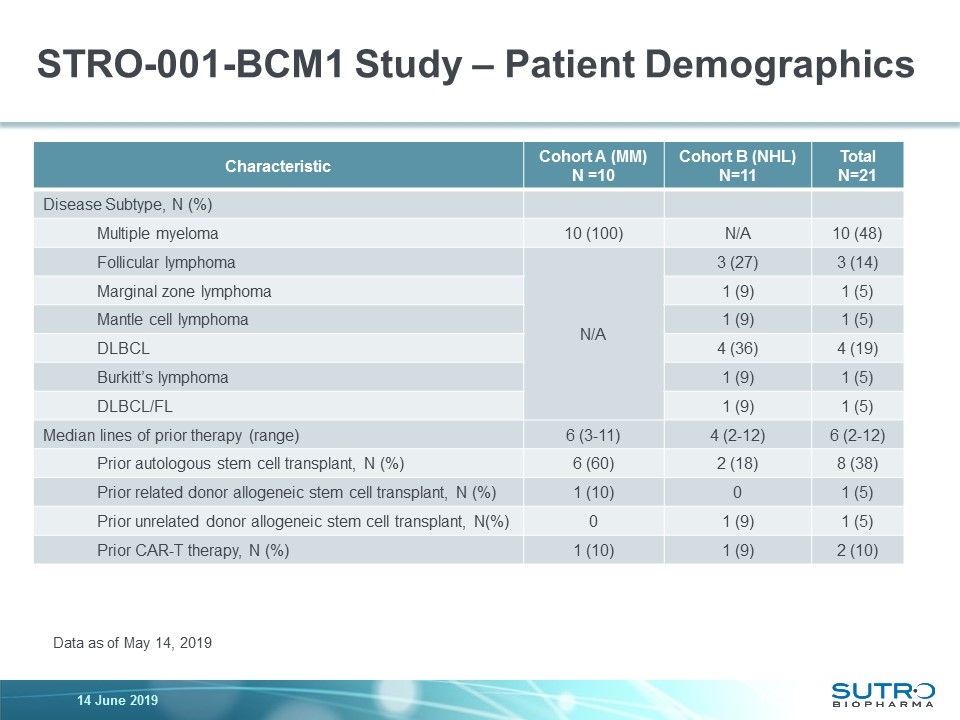
Characteristic Cohort A (MM) N =10 Cohort B (NHL) N=11 Total N=21 Disease Subtype, N (%) Multiple myeloma 10 (100) N/A 10 (48) Follicular lymphoma N/A 3 (27) 3 (14) Marginal zone lymphoma 1 (9) 1 (5) Mantle cell lymphoma 1 (9) 1 (5) DLBCL 4 (36) 4 (19) Burkitt’s lymphoma 1 (9) 1 (5) DLBCL/FL 1 (9) 1 (5) Median lines of prior therapy (range) 6 (3-11) 4 (2-12) 6 (2-12) Prior autologous stem cell transplant, N (%) 6 (60) 2 (18) 8 (38) Prior related donor allogeneic stem cell transplant, N (%) 1 (10) 0 1 (5) Prior unrelated donor allogeneic stem cell transplant, N(%) 0 1 (9) 1 (5) Prior CAR-T therapy, N (%) 1 (10) 1 (9) 2 (10) STRO-001-BCM1 Study – Patient Demographics Data as of May 14, 2019
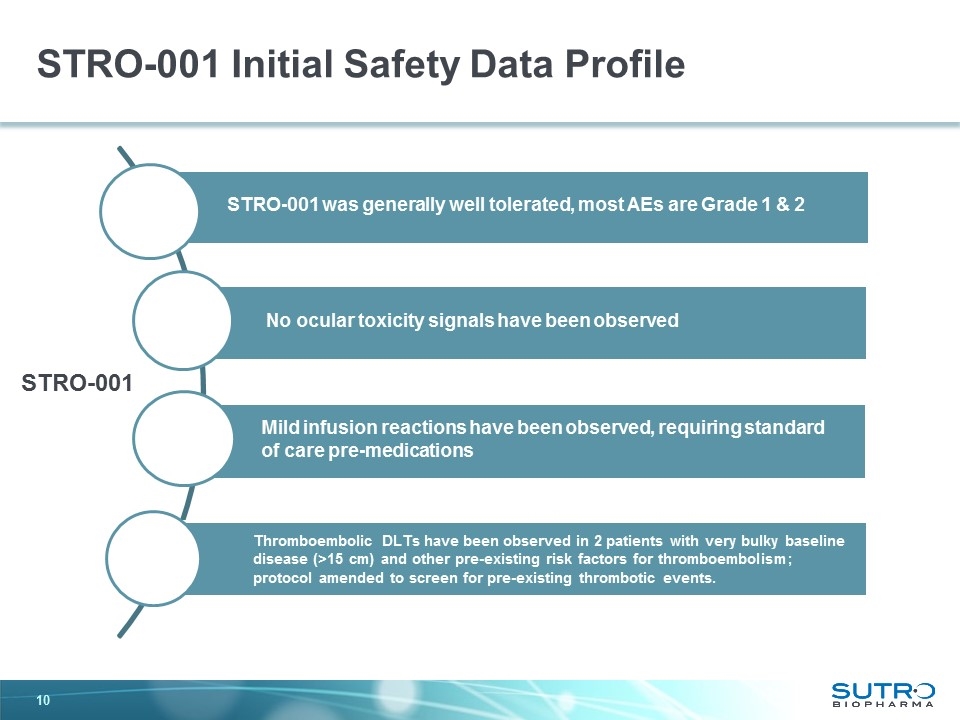
Anti-drug antibodies (ADA) have not been detected Enrollment is ongoing in the 3+3 escalation at 0.65 mg/kg in MM cohort and 0.91 mg/kg in NHL cohort STRO-001 STRO-001 was generally well tolerated, most AEs are Grade 1 & 2 No ocular toxicity signals have been observed Thromboembolic DLTs have been observed in 2 patients with very bulky baseline disease (>15 cm) and other pre-existing risk factors for thromboembolism; protocol amended to screen for pre-existing thrombotic events. Mild infusion reactions have been observed, requiring standard of care pre-medications STRO-001 Initial Safety Data Profile
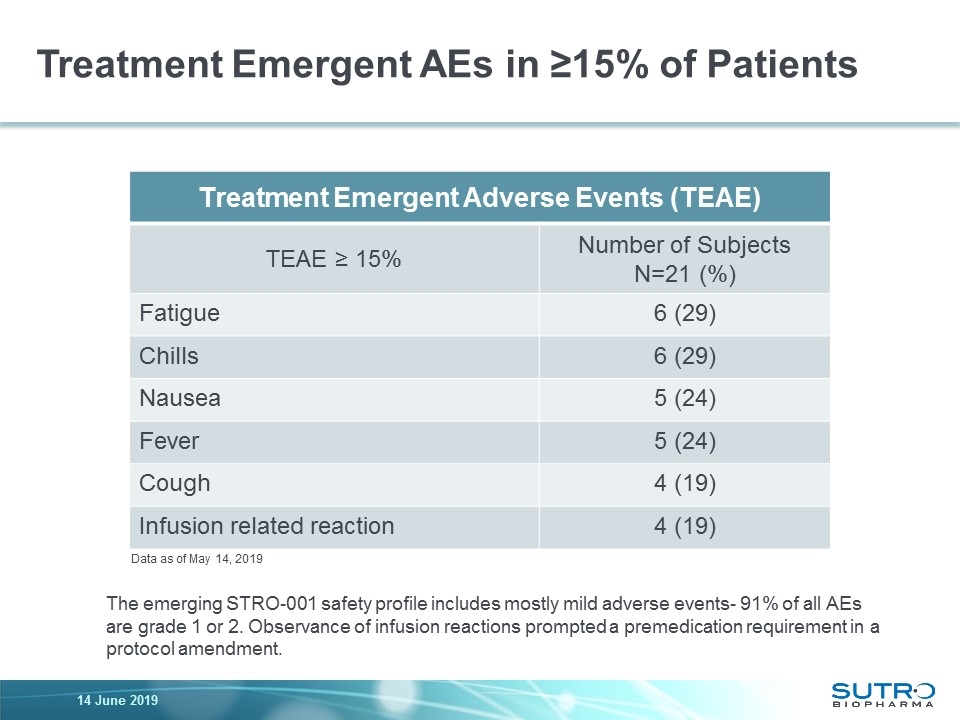
Treatment Emergent Adverse Events (TEAE) TEAE ≥ 15% Number of Subjects N=21 (%) Fatigue 6 (29) Chills 6 (29) Nausea 5 (24) Fever 5 (24) Cough 4 (19) Infusion related reaction 4 (19) The emerging STRO-001 safety profile includes mostly mild adverse events- 91% of all AEs are grade 1 or 2. Observance of infusion reactions prompted a premedication requirement in a protocol amendment. Data as of May 14, 2019 Treatment Emergent AEs in ≥15% of Patients
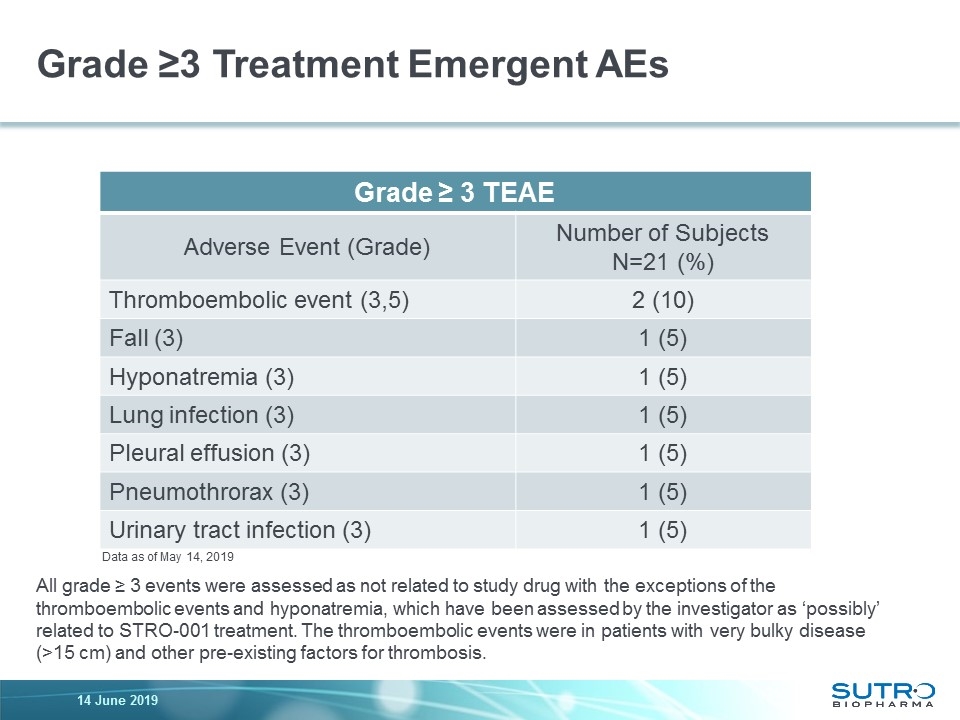
Grade ≥3 Treatment Emergent AEs Grade ≥ 3 TEAE Adverse Event (Grade) Number of Subjects N=21 (%) Thromboembolic event (3,5) 2 (10) Fall (3) 1 (5) Hyponatremia (3) 1 (5) Lung infection (3) 1 (5) Pleural effusion (3) 1 (5) Pneumothrorax (3) 1 (5) Urinary tract infection (3) 1 (5) All grade ≥ 3 events were assessed as not related to study drug with the exceptions of the thromboembolic events and hyponatremia, which have been assessed by the investigator as ‘possibly’ related to STRO-001 treatment. The thromboembolic events were in patients with very bulky disease (>15 cm) and other pre-existing factors for thrombosis. Data as of May 14, 2019
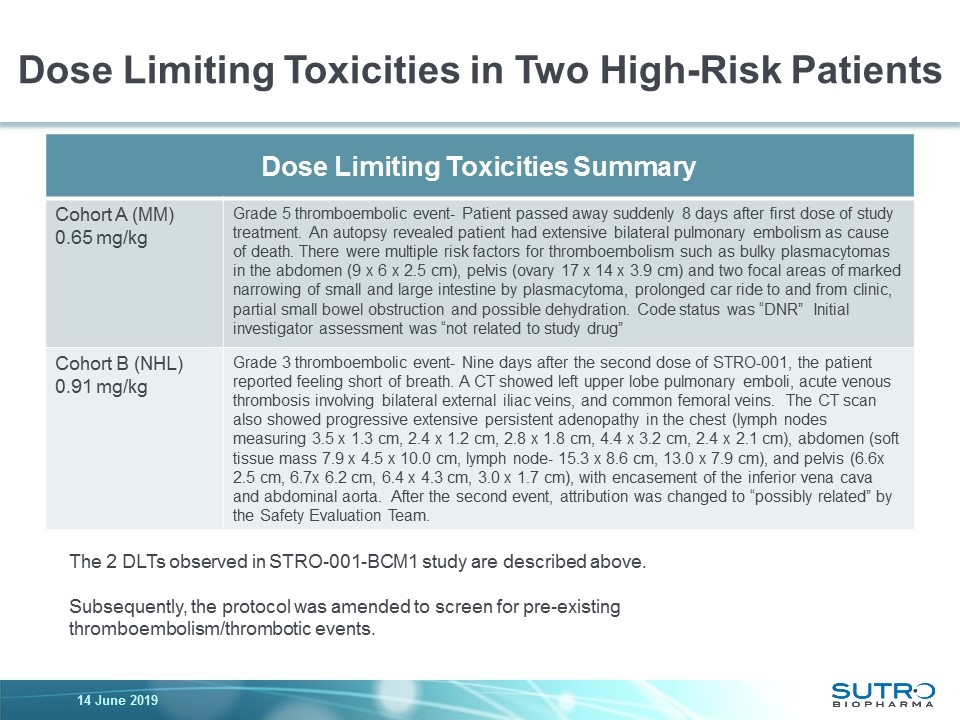
Dose Limiting Toxicities in Two High-Risk Patients Dose Limiting Toxicities Summary Cohort A (MM) 0.65 mg/kg Grade 5 thromboembolic event- Patient passed away suddenly 8 days after first dose of study treatment. An autopsy revealed patient had extensive bilateral pulmonary embolism as cause of death. There were multiple risk factors for thromboembolism such as bulky plasmacytomas in the abdomen (9 x 6 x 2.5 cm), pelvis (ovary 17 x 14 x 3.9 cm) and two focal areas of marked narrowing of small and large intestine by plasmacytoma, prolonged car ride to and from clinic, partial small bowel obstruction and possible dehydration. Code status was “DNR” Initial investigator assessment was “not related to study drug” Cohort B (NHL) 0.91 mg/kg Grade 3 thromboembolic event- Nine days after the second dose of STRO-001, the patient reported feeling short of breath. A CT showed left upper lobe pulmonary emboli, acute venous thrombosis involving bilateral external iliac veins, and common femoral veins. The CT scan also showed progressive extensive persistent adenopathy in the chest (lymph nodes measuring 3.5 x 1.3 cm, 2.4 x 1.2 cm, 2.8 x 1.8 cm, 4.4 x 3.2 cm, 2.4 x 2.1 cm), abdomen (soft tissue mass 7.9 x 4.5 x 10.0 cm, lymph node- 15.3 x 8.6 cm, 13.0 x 7.9 cm), and pelvis (6.6x 2.5 cm, 6.7x 6.2 cm, 6.4 x 4.3 cm, 3.0 x 1.7 cm), with encasement of the inferior vena cava and abdominal aorta. After the second event, attribution was changed to “possibly related” by the Safety Evaluation Team. The 2 DLTs observed in STRO-001-BCM1 study are described above. Subsequently, the protocol was amended to screen for pre-existing thromboembolism/thrombotic events.
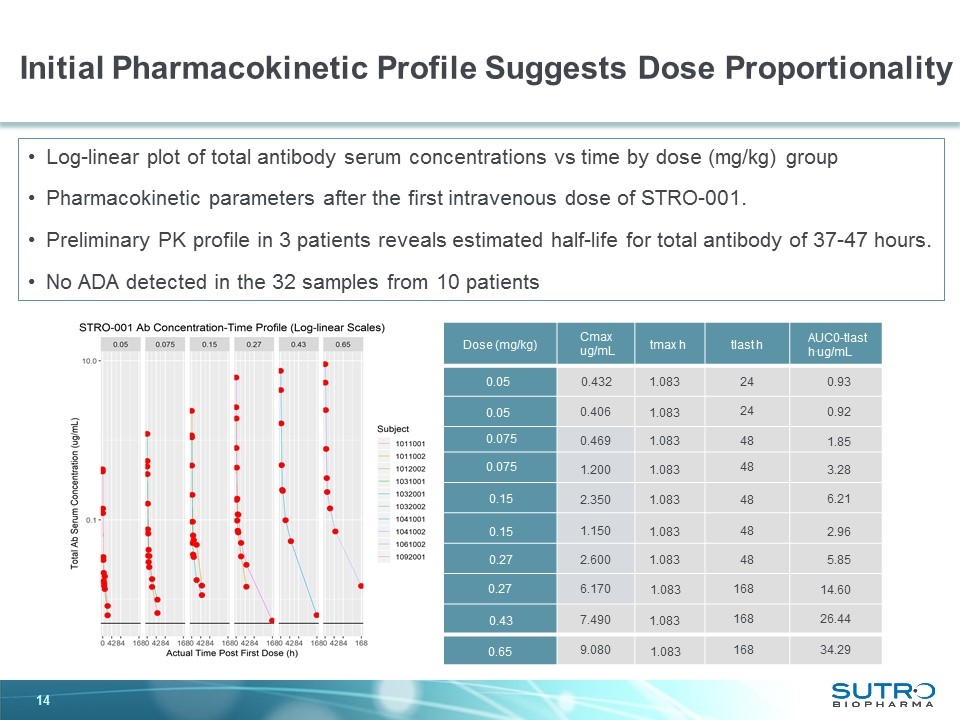
Initial Pharmacokinetic Profile Suggests Dose Proportionality Log-linear plot of total antibody serum concentrations vs time by dose (mg/kg) group Pharmacokinetic parameters after the first intravenous dose of STRO-001. Preliminary PK profile in 3 patients reveals estimated half-life for total antibody of 37-47 hours. No ADA detected in the 32 samples from 10 patients Dose (mg/kg) Cmax ug/mL tmax h tlast h AUC0-tlast h.ug/mL 0.05 0.05 0.075 0.075 0.15 0.15 0.27 0.27 0.43 0.65 0.432 0.406 0.469 1.200 2.350 1.150 2.600 6.170 7.490 9.080 1.083 1.083 1.083 1.083 1.083 1.083 1.083 1.083 1.083 1.083 24 24 48 48 48 48 48 168 168 168 0.93 0.92 1.85 3.28 6.21 2.96 5.85 14.60 26.44 34.29
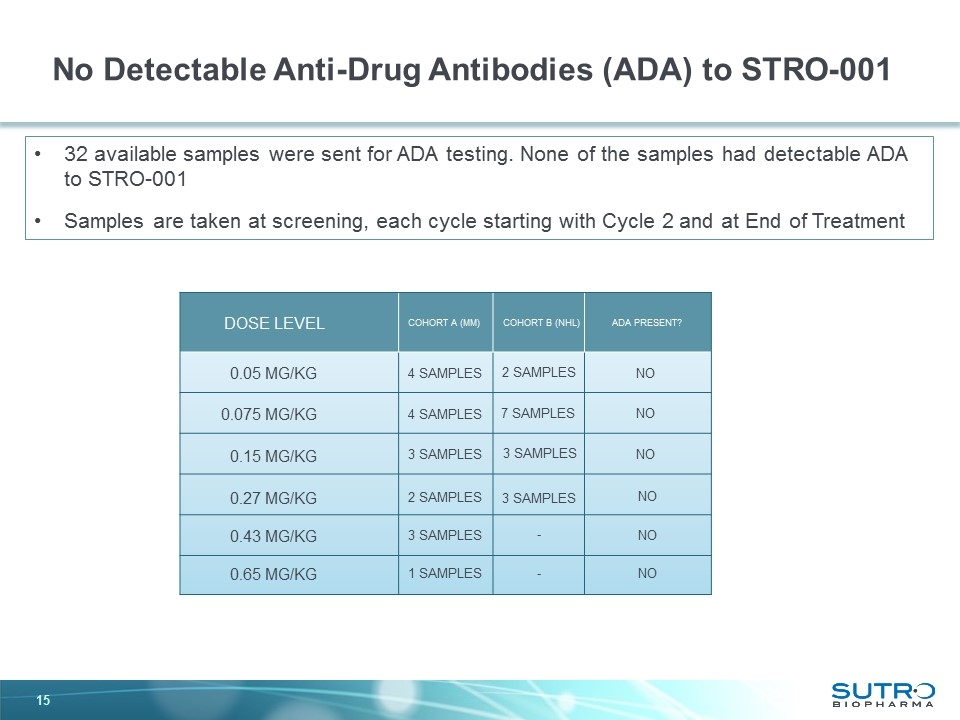
No Detectable Anti-Drug Antibodies (ADA) to STRO-001 DOSE LEVEL 0.05 MG/KG 0.075 MG/KG 0.15 MG/KG 0.27 MG/KG 0.43 MG/KG 0.65 MG/KG 4 SAMPLES 4 SAMPLES 3 SAMPLES 2 SAMPLES 3 SAMPLES 1 SAMPLES 2 SAMPLES 7 SAMPLES 3 SAMPLES 3 SAMPLES - - NO NO NO NO NO NO COHORT A (MM) COHORT B (NHL) ADA PRESENT? 32 available samples were sent for ADA testing. None of the samples had detectable ADA to STRO-001 Samples are taken at screening, each cycle starting with Cycle 2 and at End of Treatment
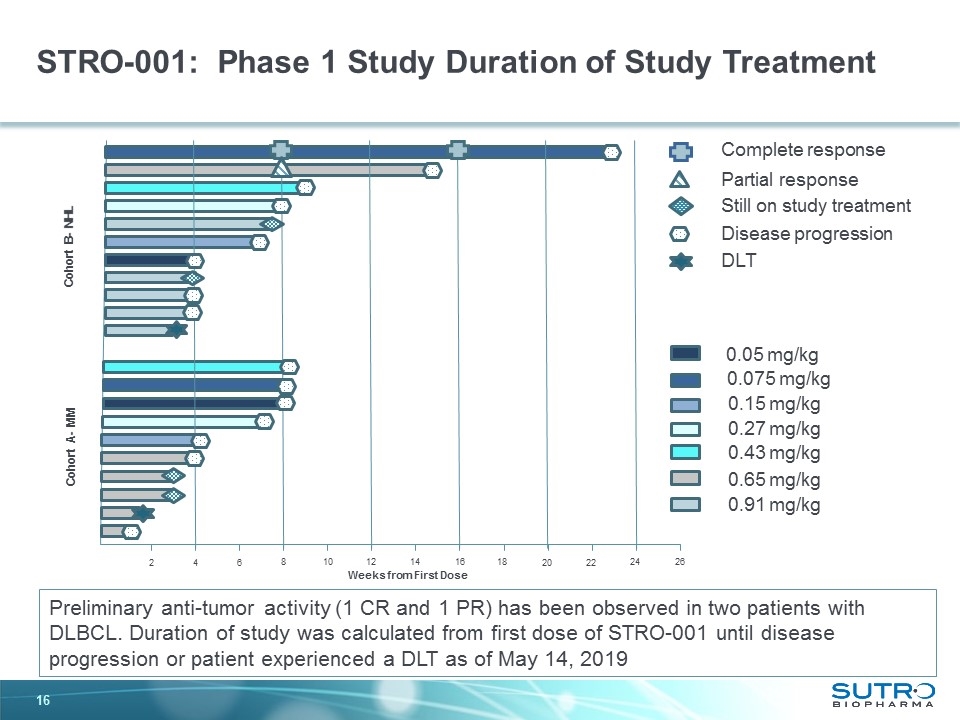
STRO-001: Phase 1 Study Duration of Study Treatment Preliminary anti-tumor activity (1 CR and 1 PR) has been observed in two patients with DLBCL. Duration of study was calculated from first dose of STRO-001 until disease progression or patient experienced a DLT as of May 14, 2019 Weeks from First Dose 2 4 6 8 10 12 14 16 18 20 22 24 26 Cohort A- MM 0.05 mg/kg 0.075 mg/kg 0.15 mg/kg 0.27 mg/kg 0.43 mg/kg 0.65 mg/kg 0.91 mg/kg Still on study treatment DLT Disease progression Complete response Partial response Cohort B- NHL
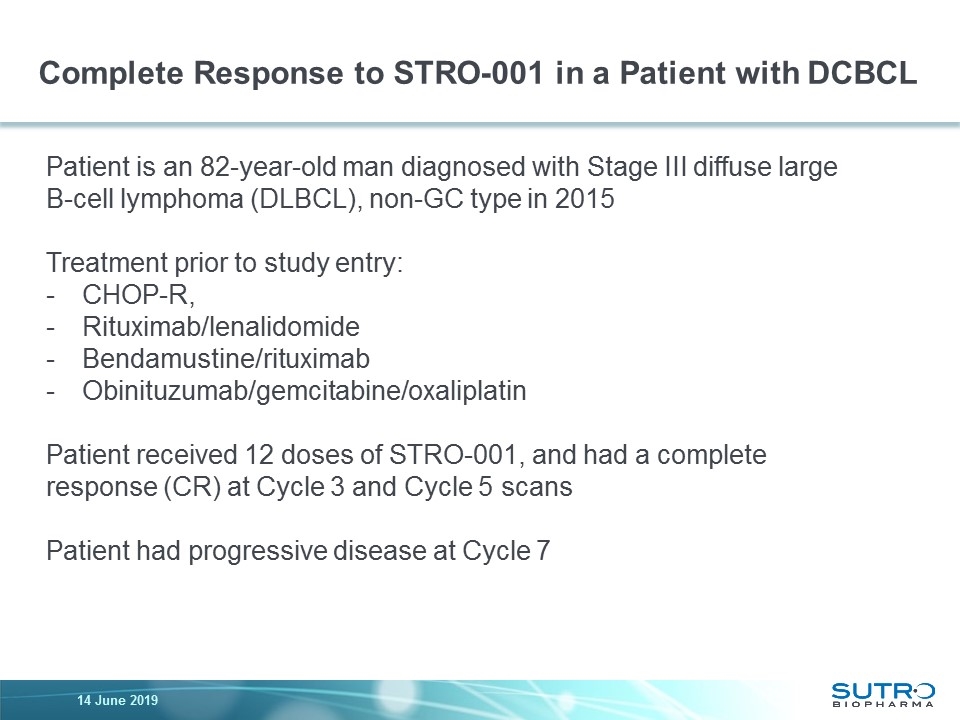
Patient is an 82-year-old man diagnosed with Stage III diffuse large B-cell lymphoma (DLBCL), non-GC type in 2015 Treatment prior to study entry: CHOP-R, Rituximab/lenalidomide Bendamustine/rituximab Obinituzumab/gemcitabine/oxaliplatin Patient received 12 doses of STRO-001, and had a complete response (CR) at Cycle 3 and Cycle 5 scans Patient had progressive disease at Cycle 7 Complete Response to STRO-001 in a Patient with DCBCL
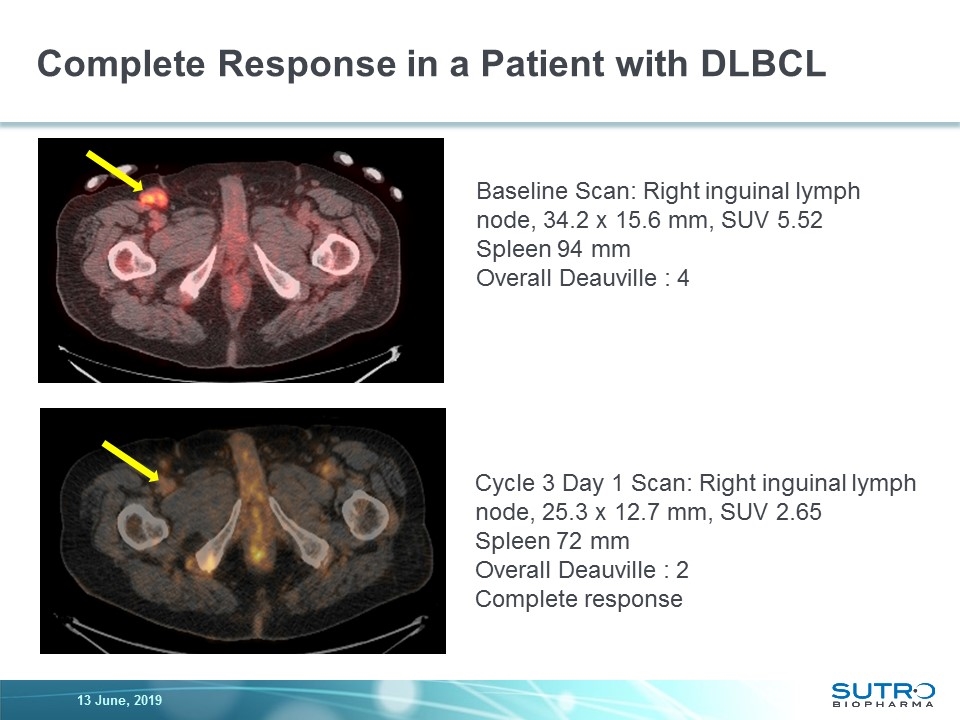
Complete Response in a Patient with DLBCL 13 June, 2019 Baseline Scan: Right inguinal lymph node, 34.2 x 15.6 mm, SUV 5.52 Spleen 94 mm Overall Deauville : 4 Cycle 3 Day 1 Scan: Right inguinal lymph node, 25.3 x 12.7 mm, SUV 2.65 Spleen 72 mm Overall Deauville : 2 Complete response
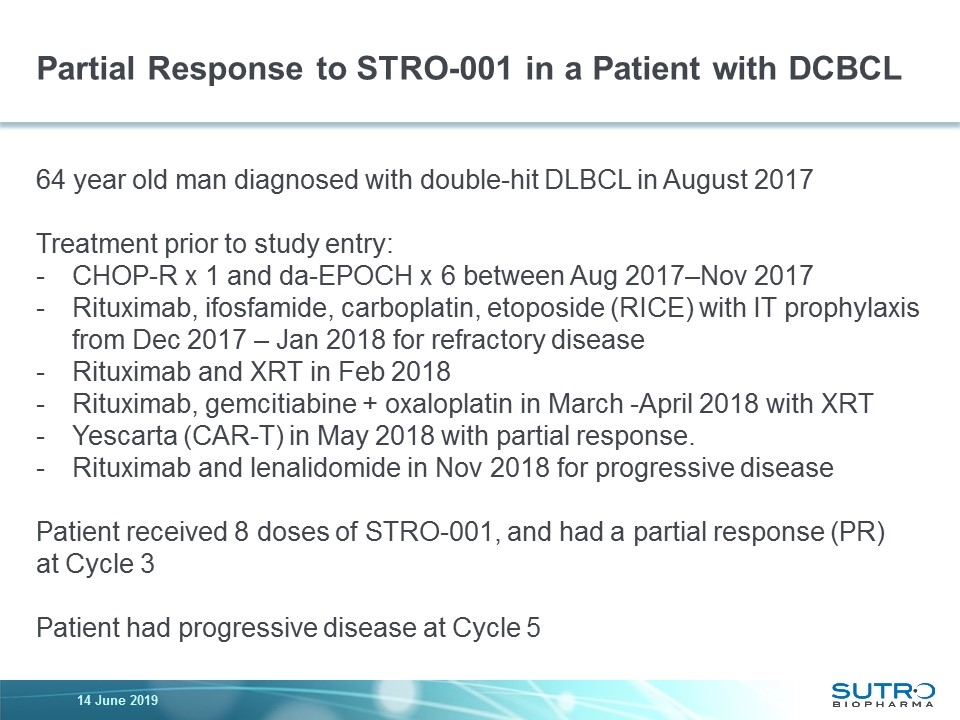
64 year old man diagnosed with double-hit DLBCL in August 2017 Treatment prior to study entry: CHOP-R x 1 and da-EPOCH x 6 between Aug 2017–Nov 2017 Rituximab, ifosfamide, carboplatin, etoposide (RICE) with IT prophylaxis from Dec 2017 – Jan 2018 for refractory disease Rituximab and XRT in Feb 2018 Rituximab, gemcitiabine + oxaloplatin in March -April 2018 with XRT Yescarta (CAR-T) in May 2018 with partial response. Rituximab and lenalidomide in Nov 2018 for progressive disease Patient received 8 doses of STRO-001, and had a partial response (PR) at Cycle 3 Patient had progressive disease at Cycle 5 Partial Response to STRO-001 in a Patient with DCBCL
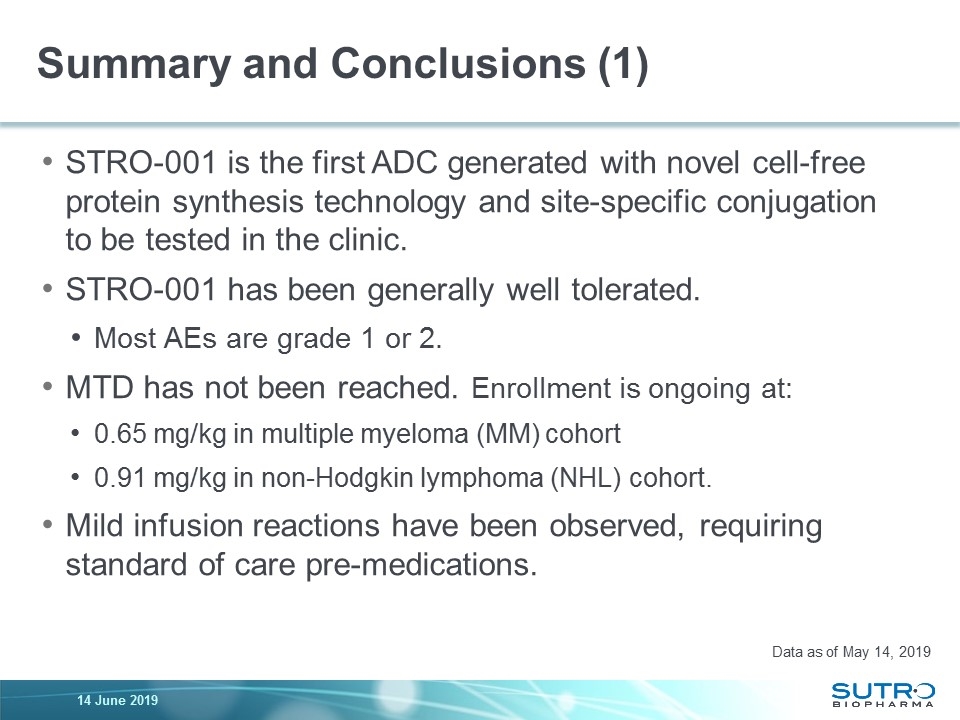
Summary and Conclusions (1) STRO-001 is the first ADC generated with novel cell-free protein synthesis technology and site-specific conjugation to be tested in the clinic. STRO-001 has been generally well tolerated. Most AEs are grade 1 or 2. MTD has not been reached. Enrollment is ongoing at: 0.65 mg/kg in multiple myeloma (MM) cohort 0.91 mg/kg in non-Hodgkin lymphoma (NHL) cohort. Mild infusion reactions have been observed, requiring standard of care pre-medications. Data as of May 14, 2019
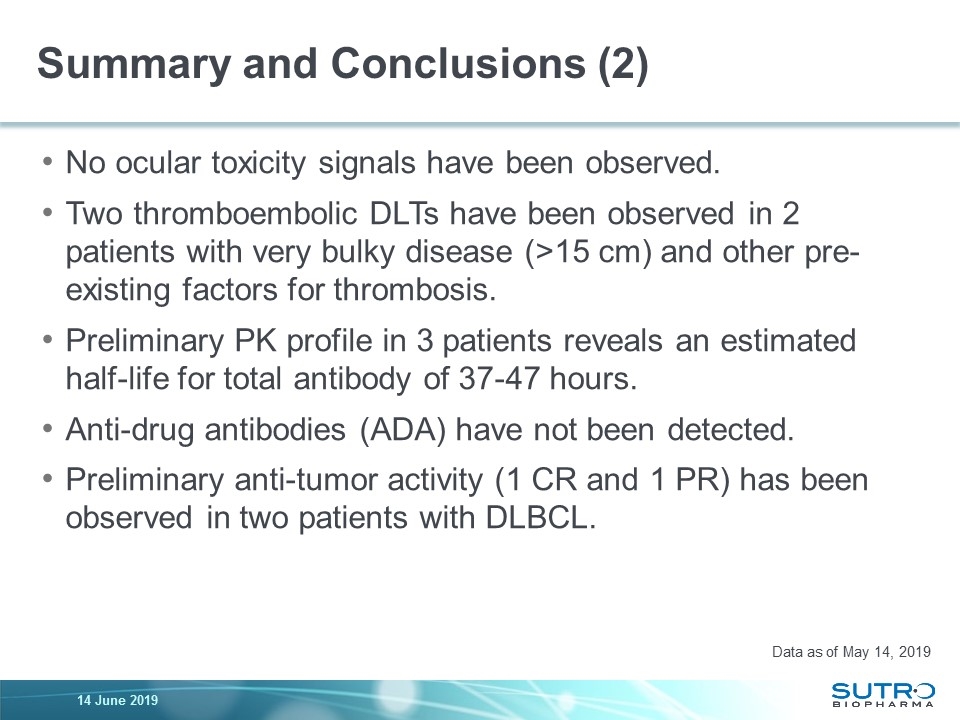
Summary and Conclusions (2) No ocular toxicity signals have been observed. Two thromboembolic DLTs have been observed in 2 patients with very bulky disease (>15 cm) and other pre-existing factors for thrombosis. Preliminary PK profile in 3 patients reveals an estimated half-life for total antibody of 37-47 hours. Anti-drug antibodies (ADA) have not been detected. Preliminary anti-tumor activity (1 CR and 1 PR) has been observed in two patients with DLBCL. Data as of May 14, 2019
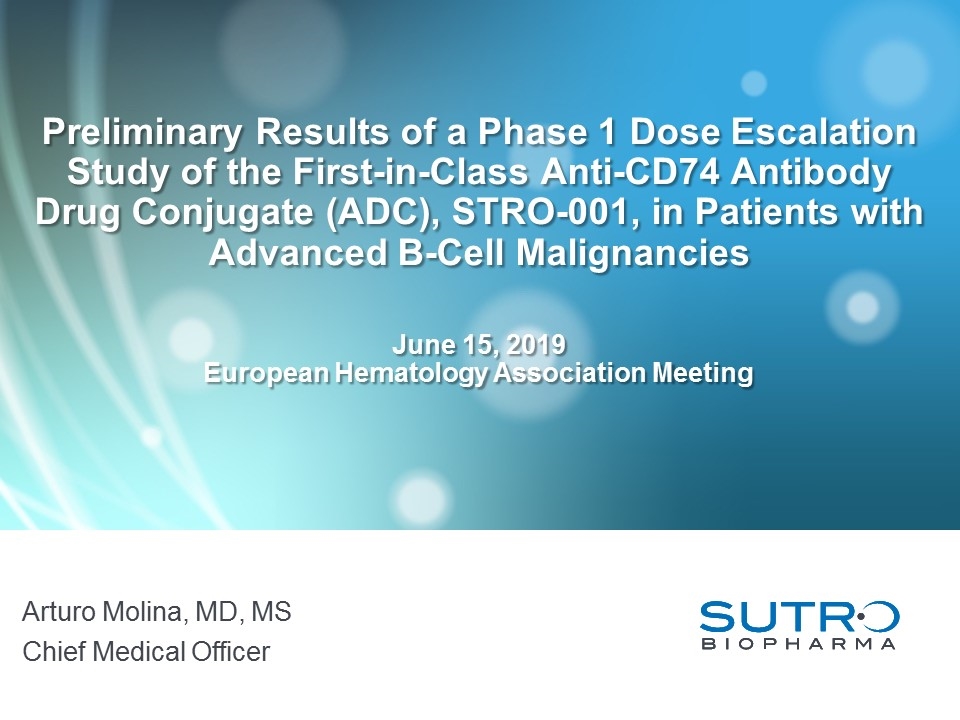
Preliminary Results of a Phase 1 Dose Escalation Study of the First-in-Class Anti-CD74 Antibody Drug Conjugate (ADC), STRO-001, in Patients with Advanced B-Cell Malignancies June 15, 2019 European Hematology Association Meeting Arturo Molina, MD, MS Chief Medical Officer